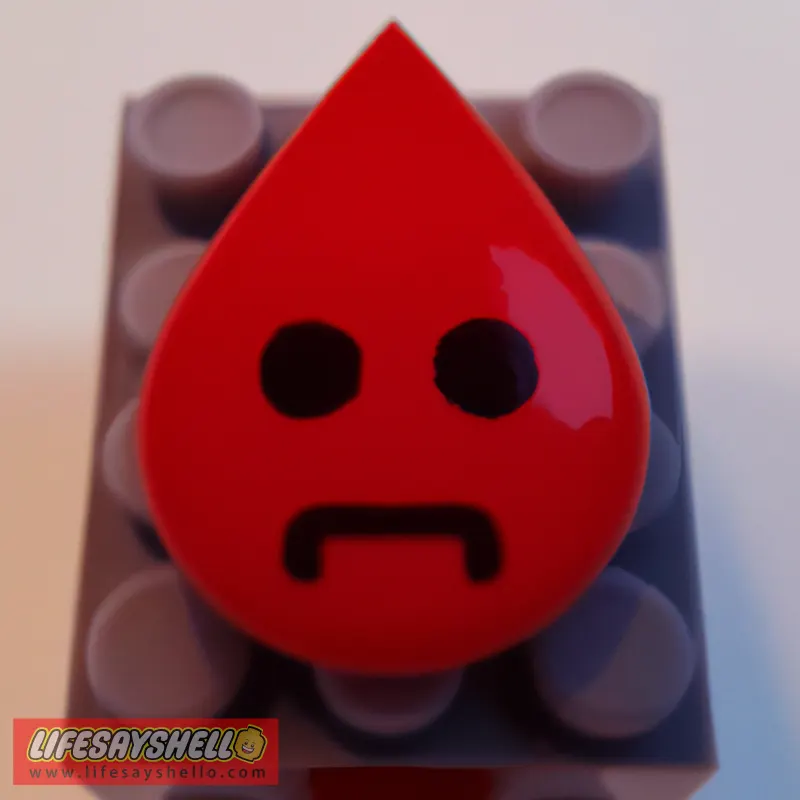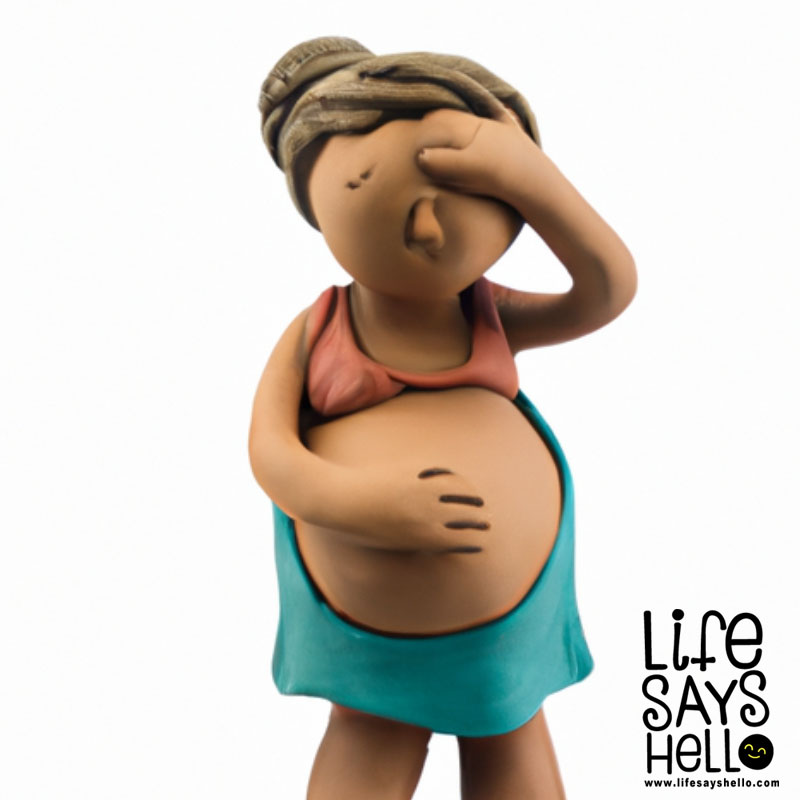Why Do I Get Blood Clots During My Period?

Have you ever noticed some thick, gelatinous, dark red clumps during your period? These are menstrual blood clots, a normal part of menstruation for many women. But what causes these clots to form, and should you be concerned if you notice some larger than normal clots? Keep reading to understand why period blood clots happen and when you should see a doctor.
What Are Period Blood Clots?
Blood clots during menstruation are a mixture of blood cells, vaginal tissue, and blood that is shed from the uterus during your monthly cycle. Clots form when blood sits or pools in the uterus before being expelled. The blood congeals and coagulates, forming jelly-like clumps.
Period clots are different than the type of blood clots that form deep in the veins, known as deep vein thrombosis. Menstrual clots are totally normal and not dangerous like clots inside the vascular system.
These clots can vary in size, from tiny specks to over a quarter in diameter. They are typically bright to dark red in color, similar to the shade of blood you see during your period. The texture is thick and gloopy, much like strawberry jam.
As the clots exit your vagina, you may see them on your pad, tampon, or in the toilet after using the restroom. Clots tend to be more common with a heavier flow.
Why Does My Period Blood Clot?
There are a few reasons why blood clots tend to form during menstruation:
Blood Sitting in the Uterus
The uterus is where the menstrual blood originates before it exits the body. If blood sits in the uterus for a period of time before flowing out, it will start to pool and coagulate. This is one of the main reasons clots form.
As your flow naturally slows or varies throughout your cycle, the blood has more time to collect in the uterus. This gives it time to clot before being shed.
Hormone Changes
Your hormones fluctuate throughout your menstrual cycle, especially estrogen and progesterone. In the lead up to your period, if these hormones rapidly change, it can impact clotting factors in the blood.
Estrogen helps keep blood vessels dilated while progesterone stabilizes the uterine lining. When these hormones drop sharply leading up to menstruation, it triggers the blood vessels to constrict and the uterine lining starts to break down.
This rush of hormone changes alters the coagulation factors in the blood, making it more likely to clot.
Heavy Menstrual Bleeding
If you have heavy periods, you naturally will have an increased chance of developing blood clots. The greater the volume of blood that flows out of the uterus, the higher the likelihood some will pool and coagulate before making it out of the body.
Plus, heavy bleeding often indicates there is an excess build up of the uterine lining that gets shed all at once during your period. This sudden shedding is associated with clot formation.
Are Blood Clots Normal During Your Period?
For the most part, having blood clots during your monthly cycle is normal and nothing to worry about. Here’s when clots are generally considered regular:
Small Clots
Clots that are smaller than about a quarter in size are common and typically benign. Seeing a few small clots when you change tampons or pads is very normal.
These clots simply represent a small amount of blood coagulating before exiting the body. Unless you notice a sudden change in the number of small clots, there is usually nothing to be concerned about.
Occasional Larger Clots
Every once in a while, a larger clot may form, even up to the size of a golf ball. As long as this doesn’t happen frequently, an isolated large clot is not alarming.
Sometimes a clot will form if you had a particularly heavy flow one cycle. The excess uterine lining shedding can occasionally clump together into a bigger clot.
When Should You See a Doctor About Blood Clots?
While small clots are no big deal, there are some scenarios where you may want to see your doctor about period clots:
Clots Larger Than a Quarter
If you routinely notice clots larger than about a quarter, it’s a good idea to see your doctor. Chronic large clots could indicate an underlying condition like uterine fibroids, endometriosis, or an infection.
Your doctor can examine the cause and rule out any possible disorders contributing to recurrent large clots.
Sudden Changes in Clot Size or Amount
If you observe any sudden changes in the size and number of clots compared to your normal flow, bring this up to your doctor.
Seeing more clots than usual or much larger clots could signify changing hormones, uterine fibroids, polyps, or other issues. Don’t ignore any abnormal differences in clotting.
Heavy Bleeding or Bleeding Between Periods
Heavy menstrual bleeding, also called menorrhagia, increases the chance of developing large clots. If your periods suddenly become much heavier than normal, with bigger clots, your doctor can help determine the cause.
Likewise, if you notice bleeding between periods accompanied by clots, it warrants a trip to the doctor to identify why the abnormal bleeding is happening.
Pain Along with Clots
Some women may experience painful cramping and passing of clots. The clots themselves are not dangerous, but the accompanying pain could indicate a problem.
Discuss the pain with your doctor to see if any treatment is recommended. Painful clots could be linked to fibroids, endometriosis, adenomyosis, or pelvic inflammatory disease.
What Causes Heavy Bleeding and Clots?
If you find yourself dealing with heavy menstrual bleeding and large clots, there are a number of possible explanations:
Hormone imbalances - Fluctuating estrogen and progesterone can affect the uterine lining and lead to heavier bleeding.
Uterine fibroids - Noncancerous growths in the uterus can contribute to heavy bleeding and clots.
Endometriosis - When uterine tissue grows outside the uterus, it can cause excessive bleeding and clotting.
Adenomyosis - The uterine lining growing into the uterine muscle wall causes heavier, prolonged periods.
Pelvic inflammatory disease - This infection of the female reproductive organs leads to inflammation and heavier bleeding.
Thyroid disorders - Both hypothyroidism and hyperthyroidism can cause abnormal menstrual bleeding.
Intrauterine devices (IUDs) - Some women using IUD contraception experience heavier bleeding and more clots.
Cancers - In rare cases, cancers of the uterus, cervix or vagina may cause heavy menstrual bleeding.
If you can’t identify an obvious cause for your sudden heavy bleeding and clots, make an appointment with your doctor for an evaluation. They can run tests to diagnose any underlying problem.
When to Seek Emergency Care
While heavy bleeding and clots are typically not emergencies, in some circumstances, you may need prompt medical care. Seek emergency care if you experience:
Bleeding so heavy that you soak through a pad or tampon every hour
Passing clots bigger than the size of a lemon
Feeling dizzy, lightheaded, or fainting due to excessive blood loss
Bleeding that persists for longer than 12 hours without slowing
Bleeding or clotting accompanied by severe abdominal pain
Bleeding that interferes with your daily activities
Fever, chills, or foul-smelling discharge along with bleeding or clots
Any of these scenarios could indicate a medical emergency requiring rapid treatment. Don’t hesitate to go to the emergency room or call 911 if you have severe heavy bleeding.
How is Heavy Menstrual Bleeding with Clots Treated?
If you find yourself dealing with heavy periods and clots monthly, your doctor can offer both medical and surgical treatment options. Here are some of the most common treatments for heavy menstrual bleeding (menorrhagia):
Medications
Birth control pills - Regulate hormones and lighten bleeding
NSAIDs - Reduce blood flow and cramping
Antifibrinolytic drugs - Prevent breakdown of clots
Gonadotropin-releasing hormone (GnRH) agonists - Stop menstrual cycles
Procedures
Endometrial ablation - Destroys the uterine lining to reduce bleeding
Uterine artery embolization - Blocks blood flow to fibroids
Myomectomy - Surgically removes uterine fibroids
Hysterectomy - Removes part or all of the uterus
Your doctor will determine which treatment method is appropriate based on what’s causing your heavy bleeding and clots. The goal is to get your menstrual flow back to normal levels.
Can Natural Remedies Help with Heavy Bleeding and Clots?
For heavy bleeding and clots, medical treatment is usually necessary. But some women find relief using natural remedies alongside their doctor’s recommendations. Here are some options:
Heat - Heating pads or hot water bottles can soothe menstrual cramps and potentially slow heavy bleeding.
Cold - Cold compresses may relieve pain and reduce blood flow.
Vitamin C - Increasing vitamin C intake could help improve blood clotting.
Iron-rich foods - Eating iron sources like red meat, spinach, and lentils improves low iron from blood loss.
Turmeric - Some research indicates curcumin in turmeric may decrease menstrual blood loss.
Cinnamon - Cinnamon is thought to have anti-clotting abilities and reduce heavy bleeding.
Ginger - Ginger tea may mildly inhibit menstrual blood loss when consumed regularly.
Apple cider vinegar - The vinegar is believed to help balance hormones and decrease heavy flows.
Always check with your doctor before trying natural remedies, especially when dealing with heavy bleeding. While some may provide minor relief of symptoms, medical treatment is still recommended in most cases.
When to Expect Clotting to Improve
If you’ve started treatment for heavy menstrual bleeding and clots, you’re probably anxious for some relief. Here’s a general timeline for when you may start to see improvement:
Medications - Allow 2 to 3 months for birth control pills or other medications to fully regulate bleeding.
Endometrial ablation - Bleeding and clotting should improve after the first cycle post-procedure.
Uterine artery embolization - Symptoms may start to resolve after the first treated period.
Myomectomy for fibroids - Relief occurs gradually over three to six months as the uterus heals.
Hysterectomy - Immediately stops all uterine bleeding and clotting.
Keep taking any prescribed medications and attend all follow-up appointments as recommended by your doctor. Tracking your menstrual flow and symptoms in a journal can help you identify when the treatment starts working.
When to Try Alternatives for Heavy Bleeding
If you’ve given your heavy menstrual bleeding treatment a fair try but still aren’t getting the relief you want, discuss other options with your doctor. It can take some trial and error to find the right solution.
Here are some general guidelines on when to explore alternatives:
Birth control pills - Try another brand or formulation after 3 months if bleeding persists.
NSAIDs - Switch to a different NSAID or higher dose if no change after 2 cycles.
Ablation - Consider repeat procedure if heavy bleeding returns after 6 months.
UAE - Discuss surgical options if heavy bleeding recurs after 2 years.
Myomectomy - Explore other surgeries if fibroids and bleeding return.
Hysterectomy - Look into hormone therapy if you had a partial hysterectomy but still have some bleeding.
Stay in close contact with your doctor and be open about how your treatment is working. There are always other options to explore if your initial treatment plan doesn’t reduce your heavy periods and clotting.
When Should You Stop Worrying About Blood Clots?
As long as your doctor has evaluated any heavy bleeding and clotting and you’re receiving appropriate treatment, try not to excessively worry. Here’s when you can relax about period clots:
If your doctor says clots are normal for your menstrual flow
After starting medications or treatment and your doctor is monitoring
When your bleeding and clotting improve to more manageable levels
If you have a diagnosed condition explaining clots that is being treated
Once clots become smaller and lighter in color
As clots happen less frequently or predictably each month
Keep tracking your symptoms and remain vigilant about any changes. But if your doctor is aware and you are being treated, try to breathe easier knowing the clots are being managed.
When to Consult Your Doctor
To recap, here are the key times to check in with your healthcare provider about period blood clots:
If you pass clots larger than a quarter
If you notice a change in clot size, frequency, or accompanied symptoms
If you experience sudden heavy bleeding
If you have prolonged bleeding lasting over 7 days
If you have bleeding between periods or after menopause
If you experience severe pain, fever, or foul discharge
If you soak through a pad or tampon every 1-2 hours
If you feel lightheaded or dizzy from heavy blood loss
If bleeding interferes with your regular activities
If you have concerns about a birth control method increasing bleeding
If you think you may have a hormone imbalance contributing to clots
If you want to discuss treatment options for heavy periods and clots
Do not hesitate to speak to your gynecologist or primary care physician whenever you have abnormal period clots. Getting the right diagnosis and treatment can help resolve clotting issues and restore normal menstrual flow.
Finding Menstrual Clot Relief
Having blood clots during your period is very common and typically harmless. But if you notice an increase in clotting or unusually heavy bleeding, don’t ignore it. Your doctor can get to the root cause and help regulate your flow again.
Clots on your period can seem alarming, but they are your body’s normal way of shedding the uterine lining. With treatment for any underlying conditions, you can get your menstrual cycles back to regular, healthy periods free of worrisome clotting.




Comments